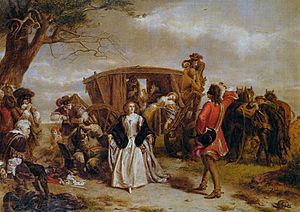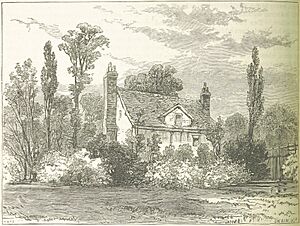Claude Duval facts for kids
Quick facts for kids
Claude Deval (The Marquis)
|
|
|---|---|

William Powell Frith's 1860 painting, Claude Duvall
|
|
| Born | 1643 |
| Died | 21 January 1670 (aged 26–27) |
| Resting place | St Paul's, Covent Garden, London, England |
| Nationality | French |
| Other names | Claude Duvall |
| Occupation | servant, highwayman |
| Known for | French-born highwayman in post-Restoration Britain |
Claude Du Vall (born 1643 – died January 21, 1670) was a famous French highwayman in England. He came from a noble family who had lost their wealth. He worked for royalists who returned to England with King Charles II.
People remember him for being very polite to his victims. He was also known for being chivalrous to women. This helped create the idea of the "romantic highwayman" in stories and plays.
Claude Duval's Early Life
Claude Duval was born in Domfront, Orne, Normandy, France in 1643. His family was noble, but they had lost their titles and land. He had a brother named Daniel Duval.
When he was 14, Claude moved to Paris. There, he worked as a house servant. Later, he became a stable boy for English royalists. He moved to England during the English Restoration period. He worked as a footman for the Duke of Richmond. He then rented a house in Wokingham.
Life as a Highwayman
The story goes that Claude Duval soon became a successful highwayman. He robbed stagecoaches on the roads leading to London. He was especially active around Holloway, between Highgate and Islington.
Unlike many other highwaymen, he was known for being very gentlemanly. He also wore fashionable clothes. People say he never used violence. One time, he robbed Squire Roper, who was in charge of the King's deer. Claude took 50 guineas from him and tied him to a tree.
There are many tales about Duval. A very famous story says he once robbed a gentleman. He only took some of the money because the man's wife agreed to dance with him. They danced a "courante" by the side of the road. This scene was painted by William Powell Frith in 1860. The painting is called Claude Duval.
Claude's polite behavior was meant to stop people from chasing him. But it didn't always work. The authorities offered a big reward for his capture. So, he fled to France for a while. He came back to England a few months later. Soon after, he was arrested in a tavern called the Hole-in-the-Wall. This tavern was in Chandos Street, Covent Garden, London.
His Execution
On January 17, 1670, Judge Sir William Morton found Claude Duval guilty. He was found guilty of six robberies. Other robberies could not be proven. The judge sentenced him to death.
Many people tried to ask King Charles II to pardon him. But the King did not forgive him. Claude Duval was executed on January 21 at Tyburn. After his body was taken down, it was shown in the Tangier Tavern. Many people came to see it.
People believe Duval was buried under the middle aisle of St Paul's, Covent Garden church. The church records show a "Peter Duval" was buried there in January 1670.
Claude Duval's story inspired many writers and playwrights. They added to his legend. Some stories claimed he knew about alchemy, loved gambling, and was very popular with women.


